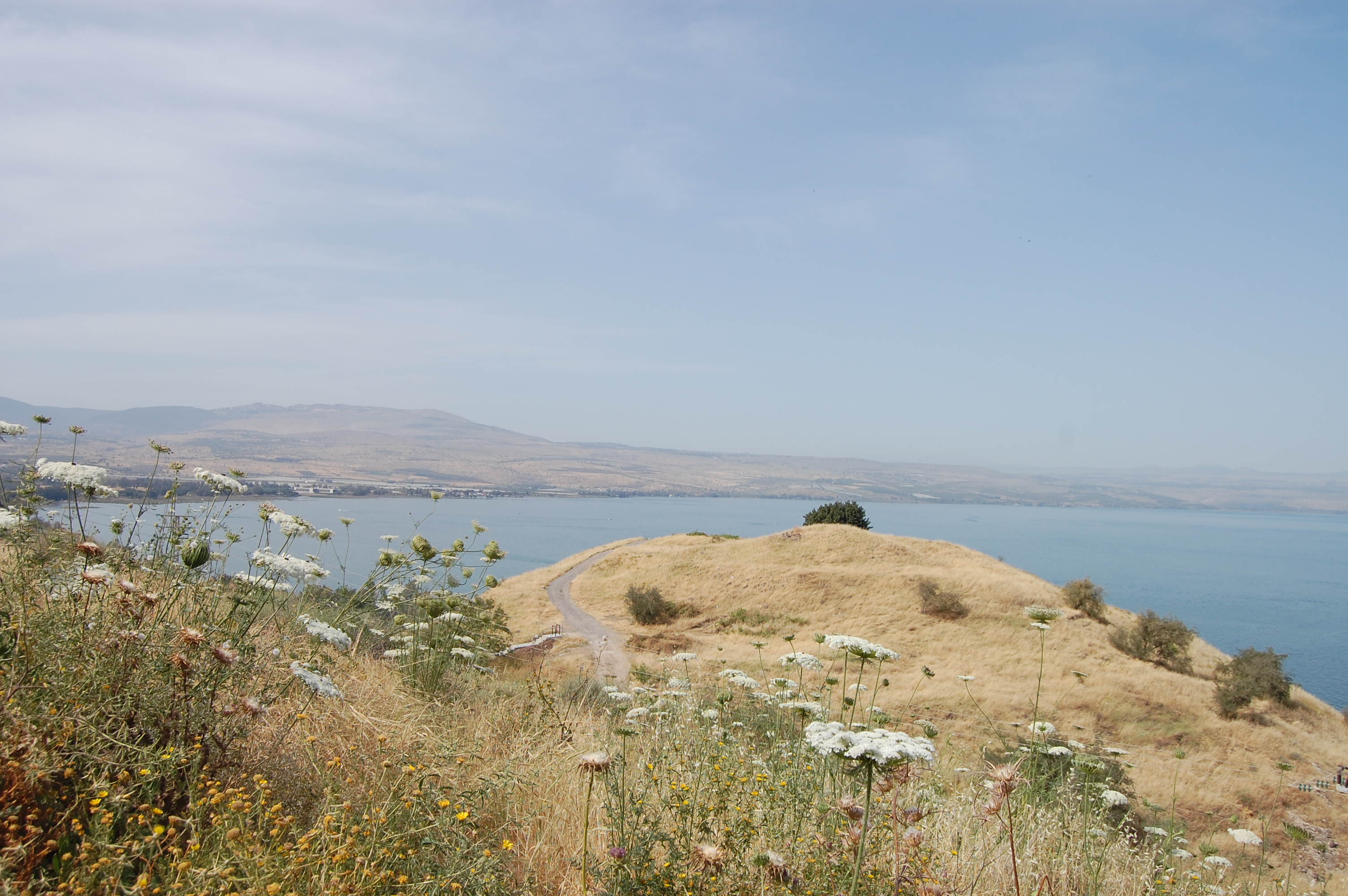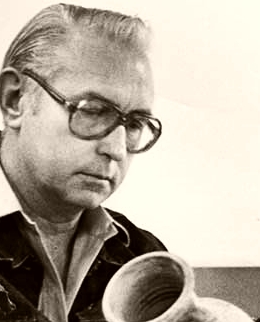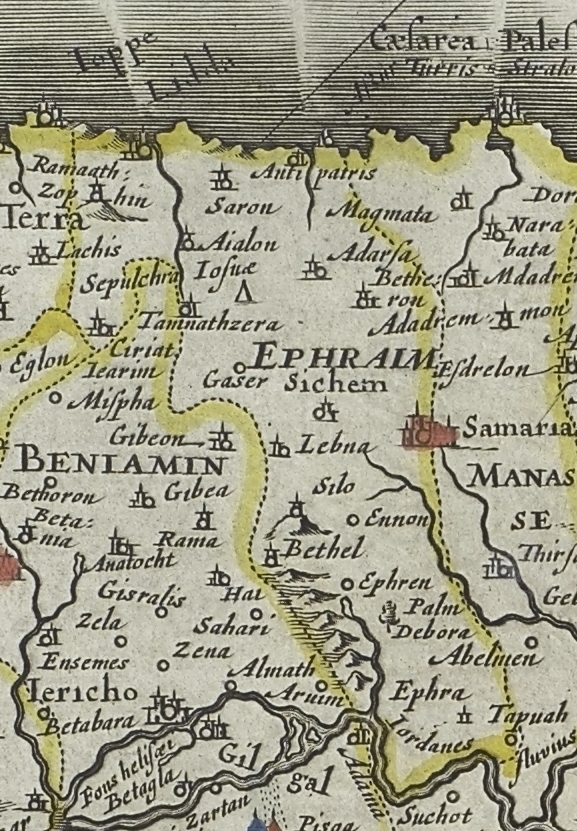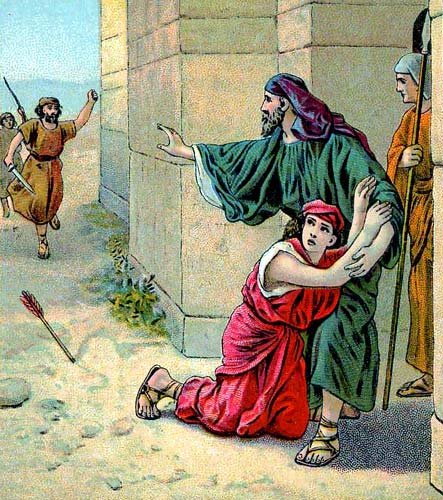|
Tel Gerisa
Tel Gerisa (Hebrew) or Tell Jerishe and Tell Jarisha (Arabic), commonly known as Tel Napoleon or Napoleon's Hill (as his army camped on it during the siege of Jaffa), is an archaeological site on the southern bank of the Yarkon River in Israel. The main phases of the city are dated to the Middle and Late Bronze Ages, with a smaller settlement in Iron Age I and going into decline in Iron Age II (10th century BCE). Excavation history Eliezer Sukenik led the excavations at the site between 1927 and 1951 on behalf of the Hebrew University of Jerusalem. The Israel Department of Antiquities excavated the site in 1976 (Yigal Yadin and Shulamit Geva). Tel Aviv University's Institute of Archaeology explored the tell between 1981 and 1995 under the direction of Ze'ev Herzog. Identification The tel is about 500 meters south of the site of the former Arab village Jerisha. The original Bronze and Iron Age name of the settlement is unknown. It was suggested that "Gerisa has been identifi ... [...More Info...] [...Related Items...] OR: [Wikipedia] [Google] [Baidu] |
Tel Aviv
Tel Aviv-Yafo ( he, תֵּל־אָבִיב-יָפוֹ, translit=Tēl-ʾĀvīv-Yāfō ; ar, تَلّ أَبِيب – يَافَا, translit=Tall ʾAbīb-Yāfā, links=no), often referred to as just Tel Aviv, is the most populous city in the Gush Dan metropolitan area of Israel. Located on the Israeli coastal plain, Israeli Mediterranean coastline and with a population of , it is the Economy of Israel, economic and Technology of Israel, technological center of the country. If East Jerusalem is considered part of Israel, Tel Aviv is the country's second most populous city after Jerusalem; if not, Tel Aviv is the most populous city ahead of West Jerusalem. Tel Aviv is governed by the Tel Aviv-Yafo Municipality, headed by Mayor Ron Huldai, and is home to many List of diplomatic missions in Israel, foreign embassies. It is a Global city, beta+ world city and is ranked 57th in the 2022 Global Financial Centres Index. Tel Aviv has the List of cities by GDP, third- or fourth-largest e ... [...More Info...] [...Related Items...] OR: [Wikipedia] [Google] [Baidu] |
Tel Aviv University
Tel Aviv University (TAU) ( he, אוּנִיבֶרְסִיטַת תֵּל אָבִיב, ''Universitat Tel Aviv'') is a public research university in Tel Aviv, Israel. With over 30,000 students, it is the largest university in the country. Located in northwest Tel Aviv, the university is the center of teaching and research of the city, comprising 9 faculties, 17 teaching hospitals, 18 performing arts centers, 27 schools, 106 departments, 340 research centers, and 400 laboratories. Tel Aviv University originated in 1956 when three education units merged to form the university. The original 170-acre campus was expanded and now makes up 220 acres (89 hectares) in Tel Aviv's Ramat Aviv neighborhood. History TAU's origins date back to 1956, when three research institutes: the Tel Aviv School of Law and Economics (established in 1935), the Institute of Natural Sciences (established in 1931), and the Academic Institute of Jewish Studies (established in 1954) – joined to form Tel Aviv ... [...More Info...] [...Related Items...] OR: [Wikipedia] [Google] [Baidu] |
Hadashot Arkheologiyot
The Israel Antiquities Authority (IAA, he, רשות העתיקות ; ar, داﺌرة الآثار, before 1990, the Israel Department of Antiquities) is an independent Israeli governmental authority responsible for enforcing the 1978 Law of Antiquities. The IAA regulates excavation and conservation, and promotes research. The Director-General is Mr. Eli Escusido, and its offices are housed in the Rockefeller Museum. The Israel Antiquities Authority plans to move into a new building for the National Campus for the Archaeology of Israel in Jerusalem, next to the Israel Museum. History The Israel Department of Antiquities and Museums (IDAM) of the Ministry of Education was founded on July 26, 1948, after the establishment of the State of Israel. It took over the functions of the Department of Antiquities of the British Mandate in Israel and Palestine. Originally, its activities were based on the British Mandate Department of Antiquities ordinances. IDAM was the statutory aut ... [...More Info...] [...Related Items...] OR: [Wikipedia] [Google] [Baidu] |
List Of Minor Biblical Places
This is a list of places mentioned in the Bible, which do not have their own Wikipedia articles. See also the list of biblical places for locations which do have their own article. A Abana Abana, according to 2 Kings 5:12, was one of the "rivers of Damascus", along with the Pharpar river. Abdon Abdon was a Levitical city in Asher allocated to the Gershonites according to Joshua 21:30 and 1 Chronicles 6:74. Abel-Shittim Abel-Shittim, the last Israelite encampment before crossing into the Promised Land, is identified by Josephus with Abila in Peraea, probably the site of modern Tell el-Hammam in Jordan. Adam Adam was a location which, according to Joshua 3:16, was along the Jordan River, near Zarethan. According to Cheyne and Black, it may be a scribal error for "Adamah". Adadah Adadah is the name of a town mentioned in Joshua 15:22, in a list of towns inside the territory of the Tribe of Judah. The name "Adadah" appears nowhere else in the Bible."Adadah", in According to t ... [...More Info...] [...Related Items...] OR: [Wikipedia] [Google] [Baidu] |
Anson Rainey
Anson Frank Rainey (January 11, 1930 – February 19, 2011) was professor emeritus of ancient Near Eastern cultures and Semitic linguistics at Tel Aviv University. He is known in particular for contributions to the study of the Amarna tablets, the noted administrative letters from the period of Pharaoh Akhenaten's rule during the 18th Dynasty of Egypt.Rollston, C. (2011)Among the last of the titans: Aspects of Professor Anson Rainey's life and legacy (1930–2011)(February 20, 2011); retrieved May 22, 2017 He authored and edited books and articles on the cultures, languages and geography of the Biblical lands. Early life Anson Rainey was born in Dallas, Texas, in 1930. Upon the death of his father that same year, he was left with his maternal grandparents. He attended Brown Military Academy in San Diego, California, from 1943 to 1946. After one semester of study there – as a cadet battalion commander – he served as assistant commandant at Southern California Mi ... [...More Info...] [...Related Items...] OR: [Wikipedia] [Google] [Baidu] |
Tribe Of Ephraim
According to the Hebrew Bible, the Tribe of Ephraim ( he, אֶפְרַיִם, ''ʾEp̄rayīm,'' in pausa: אֶפְרָיִם, ''ʾEp̄rāyīm'') was one of the tribes of Israel. The Tribe of Manasseh together with Ephraim formed the ''House of Joseph''. It is one of the ten lost tribes. The etymology of the name is disputed.For the etymology, see Ephraim as portrayed in biblical narrative According to the Bible, the Tribe of Ephraim is descended from a man named Ephraim, who is recorded as the son of Joseph, the son of Jacob, and Asenath, the daughter of Potiphera. The descendants of Joseph formed two of the tribes of Israel, whereas the other sons of Jacob were the founders of one tribe each. The Bible records that the Tribe of Ephraim entered the land of Canaan during its conquest by Joshua, a descendant of Ephraim himself. However, many archeologists have abandoned the idea that Joshua carried out a conquest of Canaan similar to that described in the Book of Joshua, seein ... [...More Info...] [...Related Items...] OR: [Wikipedia] [Google] [Baidu] |
Tribe Of Manasseh
According to the Hebrew Bible, the Tribe of Manasseh (; Hebrew: ''Ševet Mənašše,'' Tiberian: ''Šēḇeṭ Mănašše'') was one of the Tribes of Israel. It is one of the ten lost tribes. Together with the Tribe of Ephraim, Manasseh also formed the ''House of Joseph''. Biblical Chronicle According to the biblical chronicle, the Tribe of Manasseh was a part of a loose confederation of Israelite tribes from after the conquest of the land by Joshua until the formation of the first Kingdom of Israel in c. 1050 BC. No central government existed, and in times of crisis the people were led by ad hoc leaders known as Judges (see Book of Judges). With the growth of the threat from Philistine incursions, the Israelite tribes decided to form a strong centralised monarchy to meet the challenge, and the Tribe of Manasseh joined the new kingdom with Saul as the first king. After the death of Saul, all the tribes other than Judah remained loyal to the House of Saul, but after the death o ... [...More Info...] [...Related Items...] OR: [Wikipedia] [Google] [Baidu] |
Tribe Of Dan
The Tribe of Dan (, "Judge") was one of the twelve tribes of Israel, according to the Torah. They were allocated a coastal portion of land when the people of Israel entered the Promised Land, later moving northwards. Biblical narrative In the Biblical census of the Book of Numbers, the tribe of Dan is portrayed as the second largest Israelite tribe (after Judah). Some textual scholars regard the census as being from the Priestly Source, dating it to around the 7th century BC, and more likely to reflect the biases of its authors.Richard Elliott Friedman, '' Who Wrote the Bible?'' (Harper San Francisco) (1987) In the ''Blessing of Moses'', which some textual scholars regard as dating from only slightly earlier than the deuteronomist, Dan is prophesied to "leap from Bashan"; scholars are uncertain why this should be since the tribe did not live in the Bashan plain, east of the Jordan River. Conquest and territory According to the biblical narrative, following the completion of ... [...More Info...] [...Related Items...] OR: [Wikipedia] [Google] [Baidu] |
Levites
Levites (or Levi) (, he, ''Lǝvīyyīm'') are Jewish males who claim patrilineal descent from the Tribe of Levi. The Tribe of Levi descended from Levi, the third son of Jacob and Leah. The surname ''Halevi'', which consists of the Hebrew definite article "" ''Ha-'' ("the") plus ''Levi'' (Levite) is not conclusive regarding being a Levite; a titular use of HaLevi indicates being a Levite. The daughter of a Levite is a " ''Bat Levi''" (''Bat'' being Hebrew for "daughter"). The Tribe of Levi served particular religious duties for the Israelites and had political (administering cities of refuge) and educational responsibilities as well. In return, the landed tribes were expected to support the Levites with a tithe (), particularly the tithe known as the First tithe, ''ma'aser rishon''. The Kohanim, a subset of the Levites, were the priests, who performed the work of holiness in the Temple. The Levites, referring to those who were not Kohanim, were specifically assigned to * singi ... [...More Info...] [...Related Items...] OR: [Wikipedia] [Google] [Baidu] |
Benjamin Mazar
Benjamin Mazar ( he, בנימין מזר; born Binyamin Zeev Maisler, June 28, 1906 – September 9, 1995) was a pioneering Israeli historian, recognized as the "dean" of biblical archaeologists. He shared the national passion for the archaeology of Israel that also attracts considerable international interest due to the region's biblical links. He is known for his excavations at the most significant biblical site in Israel: south and south west of the Temple Mount in Jerusalem. In 1932 he conducted the first archaeological excavation under Jewish auspices in Israel at Beit She'arim (the largest catacombs ever found in Israel) and in 1948 was the first archaeologist to receive a permit granted by the new State of Israel (Tell Qasile, 1948). Mazar was trained as an Assyriologist and was an expert on biblical history, authoring more than 100 publications on the subject. He developed the field of historical geography of Israel. For decades he served as the chairman of the Israel Ex ... [...More Info...] [...Related Items...] OR: [Wikipedia] [Google] [Baidu] |
Levitical City
In the Hebrew Bible, the Levitical cities were 48 cities in ancient Israel set aside for the tribe of Levi, who were not allocated their own territorial land when the Israelites entered the Promised Land. Numbers 35:1-8 relates God's command to Moses to establish 48 cities for the Levites, of which six would also function as Cities of Refuge to which manslayers could flee. Each settlement was to comprise a walled city and the common land around it for pasture, measured radially as one thousand cubits in each direction, or as a square measuring two thousand cubits along each side. The land for the cities was to be 'donated' by the host tribe and was allocated to the Levites according to their tribal sub-divisions. 13 cities were for the Aaronites. 13 cities were for the Gershonites. 10 cities were for the Kohathites. 12 cities were for the Merarites. The six cities which were to be Cities of Refuge were Golan, Ramoth, and Bezer, on the east of the Jordan River, and Kedesh, ... [...More Info...] [...Related Items...] OR: [Wikipedia] [Google] [Baidu] |
Jerisha
Jarisha ( ar, جرِيشة, also transliterated Jerisha; he, ג'רישה) was a Palestinian Arab village located from the ancient site of Tell Jarisha ( Tel Gerisa), on the south bank of Al-Awja (Yarkon River).Ben-Tor and Greenberg, 1992, p. 246.Khalidi and Elmusa, 1992, p. 246. After the establishment of Tel Aviv, it was one of five Arab villages to fall within its municipal boundaries.Mann, 2006, p. 246. Jarisha was ethnically cleansed in the lead up to the 1948 Arab-Israeli war. History Jarisha was located only from Tel Gerisa, an archaeological site dating to the Early Bronze II period (2800-2600 BC). In the Middle Bronze period (2000-1500 BC) the site was a fortified Hyksos town. It was succeeded by a Philistine settlement around the 12th century BC. Ottoman period In the 1596 tax records under the Ottoman Empire, it was a village in the ''nahiya'' ("subdistrict") of the Bani Sa'b, part of Nablus Sanjak. It had a population of 22 Muslim households; an estimated 121 ... [...More Info...] [...Related Items...] OR: [Wikipedia] [Google] [Baidu] |






